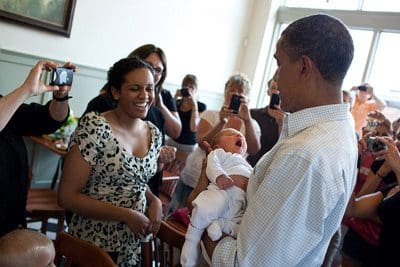How the White House, Jet.com, and nonprofits are partnering to help families nationwide
It all started with a tweet.

Official White House Photo by Pete Souza
Well before President Barack Obama and online retailer Jet.com announced the launch of the Community Diaper Program in April, White House staff had an idea: why not use technology to solve a major affordability problem facing working families every day? Building on this idea, they used Twitter to reach out to a staffer at Jet, a company that uses a unique algorithm to provide deep discounts on household products sold online from a large network of suppliers.
“They said, ‘There’s a gap in this country where one in three families can’t afford diapers to properly care for their children. Is there anything you can do to pull costs out of the supply chain and get diapers to families in need at a more effective price?’” recalls Dana Hork, Jet’s director of brand management. “So that was the call to action.”
The issue
The Administration first became aware of the diaper gap through an article in the Journal of Pediatrics that found nearly 30 percent of mothers reported “diaper need” and some families had turned to stretching diapers, a practice associated with significant immediate and long-term health problems. Low-income families typically spend twice as much as higher income families do on diapers, an average of $936 per child every year. For many, this amounts to a staggering 14 percent of their income, even before paying for other basic needs.
“If you are under financial pressure and feel you need to make those diapers last longer, you could end up with health problems for your kid,” said White House Domestic Policy Advisor Cecilia Muñoz earlier this year in a video explaining why the Administration decided to take on the issue. “The poorest families in America end up paying twice as much for diapers compared to wealthier families, which makes no sense, and it’s [a problem] we can do something about.”
It wasn’t long before the White House was referred to the National Diaper Bank Network (NDBN), an IS member whose chief executive officer, Joanne Goldblum, had co-authored the 2003 Pediatrics study with Yale University Professor Megan Smith and several other advocates. NDBN is an advocacy organization of more then 320 community-based diaper banks and diaper pantries throughout the U.S.
Goldblum says the high cost of diapers among low-income families is often due to little access to credit or transportation, a lack of big-box discount stores in urban centers and rural areas, and limited cash to spend, leading to higher per-diaper cost. In addition to health problems among children, diaper need can have negative impacts on mothers’ psychological and behavioral well-being and can lead to children’s ineligibility for daycare or early childhood programs that require diapers, ultimately causing parents to miss school or work.
Finding a solution
After learning more about the diaper gap, the team at Jet discussed a range of solutions, including one-time promotions, but ultimately decided on something more sustainable. Using Jet’s unique algorithm and supplier relationships, they could produce a high-quality diaper at a lower cost and provide an additional discount for nonprofits that distribute diapers and other items low-income families need.
“We felt we were in a position to come to the table with a solution that was both impactful and sustainable,” Hork said. “Because our core mission here is to help our customers save money day-in and day-out, and because we’ve built technology that enables them to do that, we knew we had a tool that could move the needle and bring costs down. We were also fortunate that we have great relationships with suppliers who were very receptive to the idea of participating as well.”
Working with First Quality, which manufactures Cuties diapers, Jet was able to dramatically reduce the cost per diaper by removing expensive graphics from the product packaging and increasing the size of the box to fit more diapers. They also sought input from NBDN as they worked to develop a product and create the program.
“[NDBN serves] a very important role because they’re on the ground delivering diapers to families in need,” Hork said. “They helped us understand the needs of the nonprofits and think about pack sizes and volume, and they understand the problem very well. They’re close to families and are able to shed important light on what matters to them to keep their babies clean, dry, and healthy.”
In addition to the reduced price of 17 cents per diaper available to anyone who visits the site, nonprofits can go to jet.com/jetcares to receive a unique promo code for a 25 percent discount and up to an additional 5-10 percent off if they buy in bulk and select other savings options.

“Any nonprofit organization can come to Jet.com and apply to enroll in the program,“ Hork said. “There’s no requirement that they’re a diaper bank or that they’ve distributed diapers before. We’re just trying to broaden the network of organizations who think about delivering diapers to the families that they already serve.”
Since the program launched in April, more than 800 nonprofit organizations from 48 states and DC (Jet does not ship to Alaska or Hawaii) have enrolled, and 20 percent of them, said Hork, were not distributing diapers prior to signing up for the program. IS Member Feeding America, a network of more than 200 food banks and food pantries, announced earlier this year its partnership with the White House and Jet on the initiative.
“We think that among the programs in existence to support families, few look at basic needs, and there often is not funding support for providing the little things,” Goldblum said. “We work to encourage nonprofits to include basic needs in budgets for programmatic work because without the small things people need on a daily basis, it is difficult for us to address the big things. If we want to help families succeed, we have to make sure they have everything they need.”
Goldblum says the Administration’s involvement was essential to raising awareness of the diaper gap.
“The issue of affordable diapers is a window into what poverty in America looks like,” she said. “This initiative raised awareness of the issue in a very significant way. Our hope is that private entities — Jet and others — remain active, much like Huggies has since our founding in 2011.



